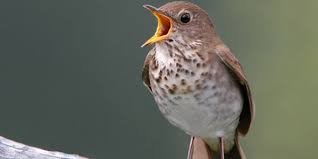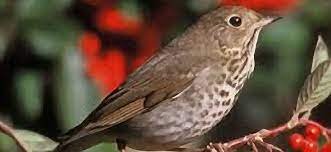There are fewer than 650,000 people living in New England, a region of the United States in the country’s northeast. This makes New England one of the least populous states in the US. Vermont’s low population density means that the state’s diverse plant and animal life may flourish. The landscape and fauna of Vermont are stunning and varied. Vermont’s Green Mountains, Lake Champlain, and the Connecticut River valley are all well-known for their abundance of forestland, which is essential for the state’s iconic avian and insect inhabitants.
Vermont ranks as the second least populous and sixth smallest state in the United States. Most of Vermont consists of forests and wide fields, making it an ideal agricultural state. Even though the Morgan Horse is Vermont’s official state horse, what bird takes that honor?
In 1941, Vermont officially adopted the Hermit Thrush (Catharus Guttatus) as its official state bird. The little, brown-and-cream bird with a patterned bib dwells in the state in every season save winter. The cold and snow of northern states like Vermont force it to follow the migration patterns of other migratory birds and head south.
Why is The Hermit Thrush Selected As The Vermont State Bird?

Almost a century ago, in 1927, seven states chose birds as their official state bird.
Each state finally agreed on a bird after fifty years. Different states have different official birds, from songbirds to raptors to chickens. Catharus guttatus, sometimes known as the hermit thrush, is an unremarkable-looking songbird known for its beautiful, mournful song.
The hermit thrush is the official state bird of Vermont, however, it can be found all over the United States. The nests of Vermont’s state bird are often built on the ground or, on rare occasions, low in trees. They build their nests in the shape of cups. On the forest floor, hermit thrushes to hunt for food, primarily insects and grubs. Catharus guttatus are primarily ground nesters that spend a lot of time foraging in decaying matter. The Vermont woods are often filled with the sound of their music.
The state bird of Vermont has a song that has been called heartbreakingly beautiful and eerily evocative. The hermit thrush’s song is often compared to a flute. The Vermont state bird’s song is an extended whistling sound that fades into a gentle reverberation. It is expected that Walt Whitman would include the Vermont state bird in his writing.
What does the state bird look like?

A Hermit Thrush’s olive-brown to the gray-brown body is complemented by a rusty orange tail. You can mistake their flanks for grey or buff, and their chest and throat are covered in spots. Their white eye rings are easily distinguishable on their faces. The feathers on their tail and wings are the brightest parts of their bodies.
About 6.75 inches in length is the average for both sexes. These thrushes, which are shorter and stockier than most others, could be called the ‘bumpers’ of the bird kingdom. However, they are not significantly heavier than other birds, with a typical weight of 0.63 to 1.31 ounces. About 11.5 inches is the span of their wings.
Catharus guttatus is primarily brown, but its tail is a bright red. Paler than its upper body, the underbelly has brown markings. Be on the lookout for the official bird of Vermont as you stroll through the woods. The hermit thrush, the official bird of Vermont, is elusive because it rarely visits feeders. During migration, though, you’re more likely to spot a hermit thrush grazing on the ground. Catharus guttatus prefers to eat berries, thus plants that produce them are ideal food sources.
What is Vermont Known For?

State insects, butterflies, animals, reptiles, dinosaurs, and flowers are just a few of Vermont’s official symbols. In addition to the hermit thrush, the northern leopard frog, the morgan horse, the monarch butterfly, the brook trout, the painted turtle, and the walleye are also recognized as Vermont icons. Vermont’s other, less well-known icons are the sugar maple, apple pie, an apple, and milk. Red clover is Vermont’s official flower.
How do these birds behave?

These birds are most often spotted in the Vermont woods found deep within the state, specifically around wetlands. They left Pennsylvania in search of warmer weather in late autumn. Their intense territorial nature is on display as they protect both their breeding and their wintering grounds. This bird prefers a winter home with lots of trees and bushes that bear berries.
In April, when spring finally arrives, the hermit thrush can be found again in Vermont. As is typical, the male of the species shows up first to claim his territory and begins courting the female. Midway through the month of May until the middle of the month of August is when you can see these thrushes nesting in your area. As a rule, they only have one clutch of chicks per year.
Male hermit thrushes are notoriously elusive. For around three or four days after the species’ female enters the breeding region, the male acts aggressively. During this period, males would chase females in a circling motion. The moment has come for him to settle down, and he gives in to the female.
It’s common for the female of the species to be the family carpenter, much as it is in many bird families. She creates the family’s cup nest on a low branch of a tree or on the floor. Whereas most bird species tend to specialize in one or the other, this thrush is capable of both. The nest is built by the bird with sticks, ferns, strips of bark, and mud, and then it skillfully conceals it from view. She stuffs it with soft, organic materials.
What do hermit thrushes eat?

The hermit thrush’s diet shifts with the seasons and its geographical location. In Vermont, it subsists primarily on insects and other tiny arthropods. It stores fat in preparation for its migratory diet. Throughout the majority of the year, this bird can be found feasting on a variety of insects, including ants, beetles, caterpillars, crickets, earthworms, grasshoppers, snails, and salamanders. Grapes, raspberries, pokeberries, elderberries, and serviceberries are among the fruits the bird eats when migrating.
Also, know about Baby Ducks
It is common practice for these birds to forage on the ground. Foraging on trees and other vegetation, they turn over leaves to reveal insects. Using these food preferences, you can entice them to your yard. Put in a bird feeder with suet, grapes, and raisins, or plant a berry bush. You can attract earthworms to your yard by making a tiny brush pile. You should be able to entice a pair of these birds if you employ both of these methods.
Searching for the hermit thrush, the official state bird will take you through some stunning landscapes.





